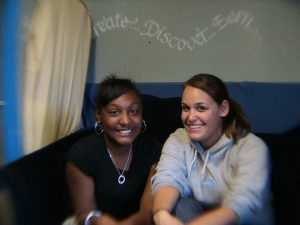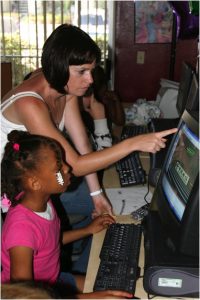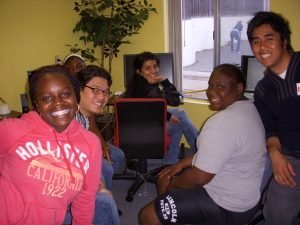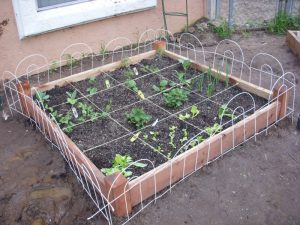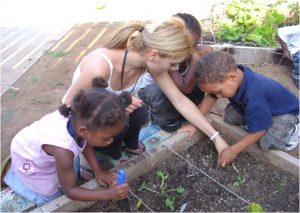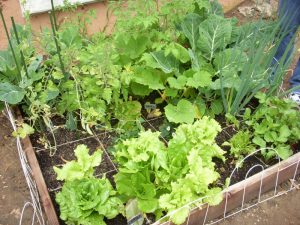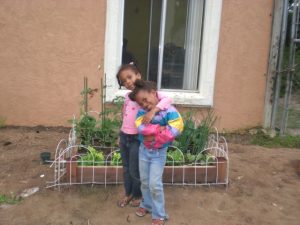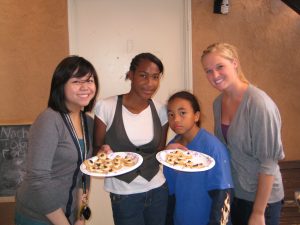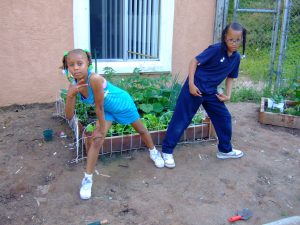In early 2007, the Director of Education at the San Diego Supercomputer Center (SDSC) approached members of LCHC about establishing a new Fifth-Dimension-style, university-community partnership in an after-school community center. The site chosen, Town and Country Learning Center (T&CLC), is housed in a federally subsidized, 144-unit apartment complex called Town and Country Village. The complex is located in a neighborhood of South-Central San Diego, where the majority of the residents are African-American. Two adjacent apartments inside the complex have been converted to serve as a community/learning center for the exclusive use of the residents.
From the beginning, it was clear that applying the Fifth Dimension (5thD) model at T&CLC would be impossible. The center had been kluged together by connecting two adjacent two-bedroom apartments located near the center of housing complex. The size and location of the rooms were such that there was no adequate space to gather the needed equipment and participants to serve as the hub of 5thD activities. Equally important, the center was open to children ranging in age from kindergarten through high school, as well as adults who came to use its computer facilities. An added consideration was that a program of age-appropriate educational and enrichment activities was already in place for the resident youth.
Organized by the site coordinator, Veverly Anderson (Ms. V), the activities were geared toward helping the youth negotiate their personal as well as academic lives. They included book clubs, teen service projects (Teen Council), an elementary-school-girl etiquette club (The Ladybugs), and money raising activities. Responding to health concerns of some of the resident women, Ms. V would also on occasion organize nutritional and exercise activities at the center.
In the process of familiarizing ourselves with the circumstances on the ground, we simply joined in and tried to help Ms. V with whatever it was she was already doing. When students needed help with homework, we helped. When the computer network was unstable, one of our team members with a computer-science background helped stabilize the network.
During this time, we kept in mind the possibility that individual activities that had proven successful in the 5thD system might be adapted for use in the T&CLC program. Of equal importance, we hoped that lessons from our past university-community partnerships could be applied in developing our relationship with Ms. V and the youth at T&CLC, as well as with the broader community of residents in the apartment complex and beyond. It was out of these circumstances that the approach we are referring to as “mutual appropriation” was born and continues to evolve. (Downing-Wilson and colleagues 2011, 2012).
What we saw emerge was a reflexive way of collaborating on the design of activities at the T&CLC that privileges and builds upon the already-established practices at the site, keeping clearly in mind that we are just as much THEIR project as they are ours. For purposes of exposition (since all of the resulting changes were linked in various ways to each other, not only in our activities at the site but in the way we organized the corresponding course at UCSD), we can crudely distinguish three parts to the mutual appropriation strategy that we formulated at the time:
- Pre-existing activities that underwent changes because of the addition of 10-12 UCSD undergraduate students to the daily program activities.
- Hybrid activities that arose from discussions among LCHC participants, Ms. V, and the young people at the site.
- New activities introduced by LCHC that could fit into the ongoing structure of T&CLC but which depended critically on the presence of LCHC and the special resources it brings to the site: new technologies; various kinds of professional expertise; and the presence of eager college students who are learning through UCSD coursework about the educational and social context of T&CLC young people’s lives as they work with them in the community setting.
It is this more or less horizontal mixing of approaches, where both sides of the partnership exercise leadership according to local norms and events, regardless of their differences, that motivates our use of the term “mutual appropriation.” LCHC has some history with the phrase, as discussed in the papers linked in this chapter, but we began to think about mutual appropriation in new and specific ways when we became involved with T&CLC. We began to understand that the partners in this project mutually appropriate the activities and the activity system in ways that further their own goals and the overarching goals of the program (in this case, to promote the development and well-being of all those involved). Not just the partners, though, the participants also strive to act in ways that are mutually appropriate. That is, they support, or at very least do not subvert, each other’s actions motivated for reasons outside the partnership.
Mutual appropriation, so conceived, was embodied in a “yours-mine-ours” collaboration that spawned new, hybrid activities that the original participants had neither conceived nor implemented on their own before they joined forces. This mutual appropriation took place on three levels:
- Among the key collaborators representing those institutions (i.e., between Ms. V and the professors and site coordinators from UCSD).
- Between activity implementers (i.e., Ms. V and the undergraduates).
- Among program participants (i.e., the undergraduates and the T&CLC young people).
Tracking Changes in the T&CLC Using the Mutual Appropriation Model
It was a central concern in this work that we document the process of creating the activities and the institutional/personal partnerships. In addition, we needed to document the organization and implementation of new activities as they appeared, captured attention and participation, and then disappeared over time. Influenced by Latour and others, we spent as much time worrying about documenting how the different partners had come together, how they interacted with each other, and their environment as we did worrying about the design of different activities or evaluation of presumed effects on the children.
Before we began our collaboration with the T&CLC community, Ms. V had been the sole site coordinator and had the difficult task of organizing activities for a group of 20 to 40 participants who varied widely in age, interests, and consistency of attendance. She had to be strategic about the kinds of activities she developed because it was impossible for her to supervise all of these groups at the same time or in the same space.
In order to monitor the flow of young people in and out of the center, she locked all entrances except for the one door that was in her line of sight as she sat at her desk. She distributed activities throughout the center according to age and proximity to her office, placing the younger children engaging in schoolwork in the areas closest to her, while the presumably more mature, self-reliant teenagers were allowed to work independently at the far side of the center. Her situation was our starting point.
As time went on and experience with different activities accrued, the structure and content of the activities changed. These changes were sometimes initiated by someone in the LCHC group and taken up by the children and/or Ms. V. At other times, they were motivated by difficulties that arose when the UCSD and the T&CLC calendar of events and did not coincide. In order to last, the program had to work both for institutional partners and for those who acted in the name of their institutions – People such as Ms. V, several residents, Professor Mike, Mr. Ivan, or Mr. Robert, Ms. Camille, and Ms. Tammy.
Pre-Existing Activities
As noted earlier, we began our partnership by helping out with the programs that were in place when we arrived. We started with Ms. V’s number one concern, homework, and we also started with her very definite ideas about how and when the undergraduates should help the kids with their homework. We soon found that we would need to make some fairly substantial adjustments to our “zone of proximal development” approach to promoting the children’s academic performance if we were going to be able to fit in.
Ms. V could not, as a practical matter, offer a great deal of individualized homework assistance, so her routine was to insist that the children completed their assignments to the best of their ability before asking for help. This very reasonable constraint led to the development of various routines whereby the “buddies” occupied themselves with other matters until a child brought them their homework to check over and ask questions about. A good deal of the discussion time in the undergraduate classrooms focused on encouraging the students to evaluate the theoretically oriented readings as related to their experiences working/playing with the children. We focused on differences between “Command-and-Control” teaching practices (with which the children were too familiar) and teaching as joint activity.
Over time the way we dealt with homework began to change. The buddies figured out ways to keep busy until the children had tried to complete their homework on their own. Ms. V eased her requirement that the children do their homework within eyesight of her office, and allowed some children to work with UCSD buddies in other areas of the learning center. When the weather was pleasant, tables would be moved outside and homework help could take place without concern for making too much noise. These adaptations not only addressed the problem of a distracting homework environment, but also allowed the undergraduates to engage the children in deeper and more focused ways than the cramped center usually permitted.
LCHC’s presence at the center also affected the way the children’s homework-related performances were recorded and evaluated. Every year, Ms. V had paperwork to do that reported on the children’s activities and kept track of their school progress. However, this was a difficult task to routinize.
Owing to our presence and the resulting increase in manpower, a concerted effort could be made to collect report cards and progress reports for each child. The buddies helped to remind the kids to bring in their report cards, or they dropped by the child’s apartment to see if a report card could be found. LCHC needed such information to document the effectiveness of its program for state-mandated impact data, requested by the Office of President for all UC Links evaluations. Ms. V needed it for her own accounting purposes. It was, however, a time-consuming task that had routinely been pushed aside by more pressing demands. An unintended consequence of actually tracking children’s progress in school was to bring into the focus the severe deficiencies in the academic achievement of many of the children. This information led to discussions about how best to support the children in their current school assignments while simultaneously providing enrichment experiences that would fill sometimes gaping holes in their knowledge that made independent completion of homework assignments impossible for many.
Hybrid Activities
With these concerns in mind, over time, activities began to emerge that are best described as hybrids of ideas from both sides of the partnership. One illustrative example concerns after-school snacks. A number of issues compromise the ability of T&CLC families to provide nutritious foods for their children. Not only are funds extremely limited for virtually all of the resident families at T&CLC, but local options for buying fresh food are virtually nonexistent while fast-food chains are ubiquitous.
As mentioned earlier, when we first started to work with Ms. V and the residents at T&CLC, food sales were a regular practice designed for raising funds for basic materials at the center. Items for sale consisted primarily of prepackaged sugary or salty snacks, or easy-to-prepare items such as nachos. The children were purchasers as well as purveyors of these snacks. The unhealthy quality of all these foods raised concerns for us. Ms. V was well aware of the health issues, but she was balancing the need to raise money for program basics and the kids’ enthusiasm for consuming these familiar snacks against her concerns about health.
Early in our work at T&CLC we began to work out an arrangement in which we supplemented the little monies that Ms. V was provided by her employers to provide snacks so that tasty/healthy snacks were obtainable. Of equal importance, we began to introduce new ways of engaging in the preparation of snacks, including the development of the Science Cooking Club. The club was initiated by a number of undergraduates who organized collaborative cooking sessions for the kids, complete with nutrition lessons that entailed Internet research to find nutritional information and recipes for foods that were both healthy and attractive to the kids. For example, fruit and vegetable smoothies were a big hit.
These cooking activities sparked a number of new projects that included making a video documentary about preparing healthy and tasty smoothies and producing a smoothie recipe book. The video and recipe book were digitized and posted to the T&CLC website, not only to showcase the collaborative work between the kids and the undergraduates, but also to allow succeeding generations of undergraduates and local youth to build upon these achievements.
In order to encourage the kids to apply their new knowledge of nutrition at home, Ms. V asked that whenever possible, the cooking activities use only ingredients that could be obtained locally. The sad fact that the only place within walking distance to buy fresh produce (in a very limited selection) was a local “99¢ Store” complicated the food project and exponentially increased the educational value of the enterprise for the university students.
The focus on healthy snacks led to another new activity, building a small vegetable garden next to the entrance to the Center. After a lot of hard digging and carpentry, a kitchen garden took shape. We soon learned that the garden generated some interesting cross-cultural experiences. Collard greens, beloved in the African-American community, were unfamiliar to the undergraduates. In their research, the kids and buddies found that the traditional ways of cooking the greens were not all that healthy. With the assistance of a local parent (who for the first time began to participate in the activities at the center), a compromise recipe was worked out that made everyone happy, including skeptical moms who tried out the results. As can be seen on the T&CLC project page, a wide varieties of projects mixing fun and learning were devised.
As these examples show, the new hybrid activities were beneficial not just in terms of providing material, educational, and social resources, but also in terms of motivating the creation of additional new activities and closer interpersonal connections. The new recipes, new garden, multiple videos and textual documents of these activities, and their representation on the T&CLC website, helped create a network of interrelated artifacts and practices that the undergraduates and youth could draw upon from one year to the next as they redesigned existing activities and developed new ones. These documentary and representational practices also fit perfectly with UCSD’s ethos of encouraging reflection and communication about site activities and with Ms. V’s custom of staging quarterly block parties for the youth and local residents. We grasped the opportunity provided by these parties to present the products of the children’s work to their community. As others have shown (i.e., McLaughlin & Brice-Heath, 1993) such public presentations can be a source of motivation for new joint projects.
New Activities Introduced by the University Partners
With Ms. V’s approval, LCHC has also introduced a number of activities geared toward developing the T&CLC kids’ interests in, access to, and knowledge of science, technology, engineering, the arts, and math (what we have learned to call a “STEAM curriculum”). Over time, several such UCSD-initiated projects have been implemented at T&CLC. Some have involved math, reading, and writing. Others encouraged physical exercise, including one activity called the “Bod Squad.” Developed by a UCSD tri-athlete, the Bod Squad introduced pedometers into races around the apartment complex’s circular drive. After the race, participants compared results and calculated averages to see how they were doing. Others expanded existing activities such as jump rope and freeze tag to include academic elements. More difficult to study forms of activity often became the motivation for graduate thesis-level projects such as the two described briefly below.
The Oceans World Activity: From a fleeting interest to a deep involvement
The first decade of the current millennium was rich in its production of online, educationally motivated, virtual worlds that seemed to have sufficient general interest to be used as afterschool activities. The first such activity we became engaged with involved building a virtual world, called “Worlds of Internet Technology and Science” (WITS). Similar in look and feel to “Second Life,” WITS uses a kid-friendly computer programming language designed to easily incorporate flash animations, digital photos, and videos. These arrangements made it possible for the children to build a variety of environments, fill them with objects collected from various media, and display them in an attractive fashion to others. The builders of WITS were interested in learning if this kind of facility would be useful in after-school science education, and we were interested in learning whether our flimsy Internet architecture would allow us to implement WITS to assess its usefulness.
When it was first introduced, WITS attracted a number of the elementary and middle school children who built rooms, filled them with pictures, and explored the potentials of this world-building program. But after a few sessions, they lost interest. Because we were obligated to “push the envelope” of WITS’s potential as a condition of our use of the program, Ivan Rosero, a graduate student in the lab, sought to redesign the way in which WITS was implemented so that would be motivating for the kids and youth. With the support of the Scripps Institute of Oceanography, which was interested in extending its public education program, and an allied grant from the National Science Foundation, Ivan developed a program he called the Ocean World Activity (OWA). It became a club within the structure of T&CLC, in which a group of elementary school girls explored topics in marine science. Ivan used a partially designed WITS undersea world as one component of a multi-modal activity that included a visit to the local aquarium, use of plush toys representing various ocean creatures, and artwork to be placed in the WITS virtual ocean.
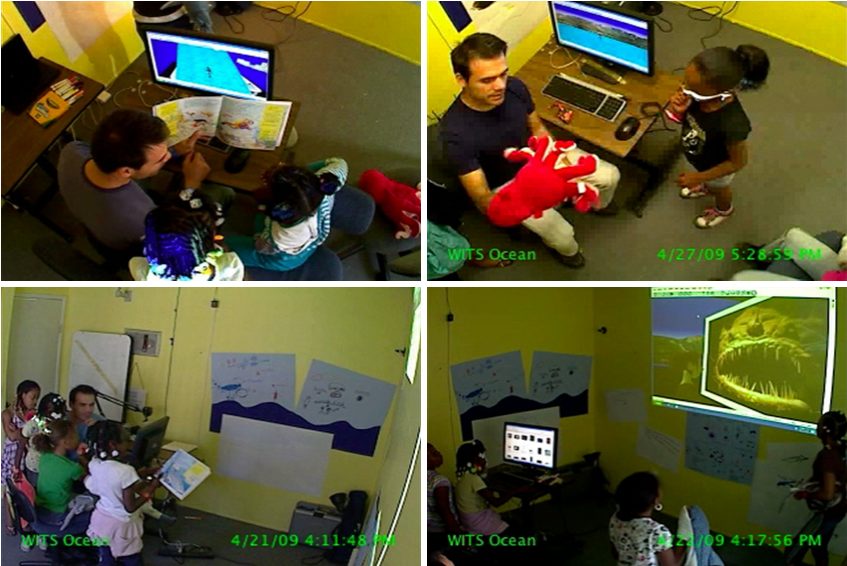
This research evoked a good deal of excitement at Scripps when it was first presented. The scientist/educators were all in favor of the kind of community engagement represented by Ivan’s program. They were enormously impressed to see these young Black children, whose dialect of English was sometimes difficult to understand, explain basic oceanographic concepts involving tidal zones and using the correct scientific names of otherwise esoteric sea creatures in creative ways. As one colleague enthused, “Children from that demographic do not use that kind of language!” Unfortunately, the National Science Foundation did not appear to value such outreach by Scripps. Local enthusiasm notwithstanding, funding for this line of research was not renewed.
Overall, it seems fair to conclude that the OWA activity proved to be a successful implementation of a STEM science program after-school in a poorly resourced neighborhood. Its lack of value to its funders bespeaks larger political economic forces at work that. For further information, see An Informal Learning Space in the Making (Rosero, 2010).
The Physics World (PWA): Mediating the Formal/Informal Divide in University-Community Telementoring Interventions
A second project, conducted by Robert Lecusay, studied a different kind of technological arrangement for creating effective afterschool STEM activities at T&CLC. A key feature of this project was that it sought to garner resources from research projects focused on distance education using the video capacities of Skype and similar facilities. Its scientific focus was on electricity. The overall “macro” structure of the project is displayed in the figure below.
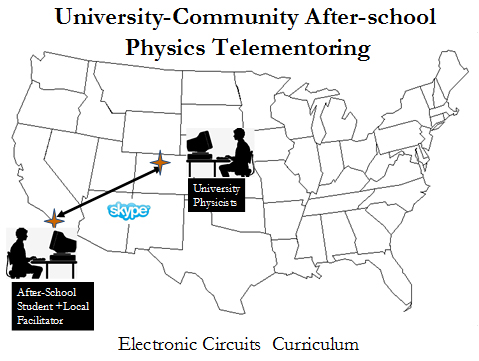
Locally, the activity was housed in the same dedicated room at T&CLC where Ivan’s OWA had taken place. The room allowed flexible workspace and adequate audio and visual recording.
The activity at T&CLC sometimes involved the presence of the distant tutor while at other times the local participants (including Robert and/or an undergrad participant) worked to figure out how electric circuits function and how to make a film that demonstrates the principles involved.
This kind of project drew support from our physics colleagues who, like us, were concerned with means of extending the reach of effective educational practices through the Internet and wanted to encounter first hand the problems involved. We were all skeptical about the prevailing policies regarding Internet access in poor and rural communities, but we were confident that we could learn an enormous amount from the inevitable work-arounds that we were certain to meet.
The common wisdom against which we were working was that there is a technological fix to providing educational access for marginalized populations by building big data canals, enabling rapid, broadband, and access to the best educational materials available. According to this policy view, the right level of technical resources yields “direct instruction” between physically separated teacher and student.
Our experience convinced us that this kind of policy initiative would fall far short of its mark because of unrealistic expectations about what access really entails at the other end of the Internet pipeline. For one, the local facilities are likely to be too weak to digest the data streams aimed at them. In addition, the transmission theory of scientific communication behind such initiatives often ignores local interpretation of the uses and values of the technology, and consequently fails to take into account, plan for, and budget for, the special form of local organization that is required to make STEM communication effective.
What the PWA demonstrated after all of the glitches of broadband high-speed access were resolved, was that creating effective learning sessions at the center required a difficult resolution between two broad forms of orientation to the problem. Locally, in the culture of the T&CLC and the informal learning environment of the PWA, the participants were very much focused on getting things to work. Meanwhile, on the side of the physics experts (channeled locally by Robert), it was important that the children grasp the principles of physics.
What emerged from this work were examples of both successful and unsuccessful strategies to bring the technical and social resources of the local “idioculture” of T&CLC in line with the expectations of the physics experts. The transformation of resources in locally meaningful, learner-relevant ways required Robert to deploy a variety of mediational strategies to resolve the “logocentric” approach of the physics with the programmatic concerns of the local participants. The results were unquestionably educational for everyone involved. But, while very useful for enlivening the overall repertoire of T&CLC activities and for providing evidence relevant to ongoing theoretical issues of concern to LCHC and others, it was too labor intensive an effort, requiring too much local modifications and resources, to maintain.
Overall, this work, described in more detail on the projects page, served as both a cautionary tale and a contribution to understanding the difference between formal and informal learning environments where the logic of schooling and the logic of everyday problem solving intersect.
Chasing A Runaway Object
Once we began to spend time regularly at T&CLC, the fact that the center was right in the children’s community made the everyday home lives of the children visible in the comings and goings between apartments and the center. The multiple concerns we encountered quickly made us aware that helping to build an effective after-school program involved a good deal more than providing academic support. Runaway object is a term coined by Yrjö Engeström, who explains the meaning of the term as follows:
“Objects are concerns, they are generators and foci of attention, motivation, effort and meaning. Through their activities people constantly change and create new objects. [Runaway] objects are often not intentional products of a single activity but unintended consequences of multiple activities. [Runaway objects] have the potential to escalate and expand up to a global scale of influence. They are objects that are poorly under anybody’s control and have far-reaching, unexpected effects…” (Engeström, 2009, p. 304).
In earlier years when we had conducted the 5thD in after school settings, it was always in a space set apart as a separate activity between the school and the home. At T&CLC, it was two apartments converted into a community center, the ground floor of an existing four-plex. Family life flowed through the center with the children, their caretakers, and other residents whose frequent visits made the center a busy place.
As a consequence of these circumstances, we were quickly confronted with the fact that at T&CLC the multiplicity of the needs of the children extended well beyond anything we had taken on before. We were not dealing with a few “special needs” children, who needed some academic assistance. At T&CLC, we were dealing with a special-needs community. Health problems appeared in the form of widespread obesity and diabetes among the children’s caretakers as well as the children. Unemployment was so bad that families were constantly moving out because they could no longer afford subsidized housing. Healthy food was not locally available, and affordable healthy food was an oxymoron.
Initially we began by incorporating new activities reflecting these different concerns into the existing programming at the center. A number of the hybrid activities described above had this character, but we were clearly coming nowhere near addressing the situation adequately with such restricted means.
To increase the reach of our efforts we contacted colleagues in the medical school for help in organizing educational activities for parents. We began to collaborate with our colleagues in Calit2, the UCSD based technology center that takes an interest in uses of new technology for health and education. We contacted local community organizers who focused on issues of food justice. We searched for, and found help from, UCSD Extension.
At first, it seemed that the addition of new activities and bringing in different constituencies of local residents would fit well within our mutual appropriation approach, but we soon discovered that there can be too much of a good thing. At total capacity, we found it an effort just to maintain the enrichment activities that were central to our research. Before long, we were spending so much of our time coordinating with all of the new organizations whose expertise we were calling on that we no longer had any time for analysis of what we were doing, and we could no longer even specify our object of analysis!
The Center For Community Well Being
As might be expected, the strains that we were experiencing were also being experienced, in their own way, by all of the parties we had involved at T&CLC. As a consequence, while we continued to develop the T&CLC activities, we also banded together with colleagues from the university as well as the larger community that is home to the T&C Apartment complex to create the Center for Community Well-Being (CCW). The CCW took on the task of engaging the runaway object that emerged at T&CLC. We began with big intentions:
Since September 2007, key personnel from the Center for Community Well-Being (CCW) at UCSD have been engaged in discussions with community leaders about how to improve collaborations in the areas of health, education, safety, and community development. Our key strategy is to better integrate existing, isolated efforts not only within the community and within UCSD, but between university and community. Our experience has made amply clear that both community and university efforts to address acute social problems are generally “stove-piped” rendering assistance and self-help efforts dysfunctional. CCW has been designed to minimize such problems by maximizing community input into the process of developing research ideas and in implementation, evaluation, and dissemination of research results. We are organizing our work so render transparent communication among participating parties during the entire process so that research dissemination and service delivery will be anticipated and accepted by both community and university. If our approach is successful we believe that this model can be transported to other community/university settings where relevance, implementation, and dissemination of research are maximized. Notable in this proposal is the collaborative involvement of health researchers, behavioral and social scientists, and communication technology specialists.
At this early stage in the development of T&CLC, our research topics could only be stated broadly, but they indicate rather accurately the directions in which the activities of the center took placed and have lived on. Writing at the time, we put our research aims in the following terms:
- If we can coordinate health provisioning and educational services in key community settings, will we be able to create a synergistic system of activities that will have a positive impact on the school performance of the community’s children and the health of all community members?
- Using new information technologies being developed by Calit2 in connection with local institution building, will we be able to facilitate the integration of physical and social infrastructure to create reliable and scalable systems of community health and other social services in a manner that can significantly reduce health costs while extending health benefits?
- Can we use the visualization systems to be located in each cooperating institution to actually induce a local sense of community?
- If we integrate research and teaching and engage community participation, will we both increase recruiting and retention of underserved students with expertise in working in interdisciplinary projects focused on important social issues and provides a significantly increased pool of young professionals who can grow such activities in the future?
The Center for Community Well-Being existed as an active research collective for several years. It served as a hub with active participation from representatives of various UCSD faculties as well as representatives of various community organizations. In addition, it gave rise to a number of experimental programs that, in one form or another, exist a decade after the effort began, although now distributed across somewhat different institutional segments of UCSD.
For additional information about CCW, see:
- The Center for Community Well-Being
- UCSD TV story from 1997 about 5thD work and after school projects
- An article that outlines UCSD’s Knowledge Exchange Corridors
- A Knowledge exchange corridors panel discussion video
- Community Open House from the non-profit community design and fabrication center, Fab Lab, San Diego
The Community Stations Project
As a result of the new social connections that were made through the activities of the CCW, it became clear that a subset of the participants were interested in some combined engagement involving community organizations and UCSD’s academic program, similar to the general model of UC-Links, but varying in their particular emphases. Particularly promising appeared to be a kind of geographical felicity involving T&CLC and two other programs, one conducted by Teddy Cruz that paired UCSD with Casa Familiar, a Center just north of the Mexican border, which in turn was partnered with a center just to the south of the border. Bud Mehan conducted the second program in collaboration with Sukumar Srinivasan, from UCSD Engineering, focused on the Earth Lab, a collaboration focused on local ecology.
In a series of meeting with Ramesh Rao, head of Calit2 (now the Qualcomm Institute), the possibility was raised of providing several then-new, high tech data sharing facilities that could operate wirelessly to connect UCSD with each of the “community stations.” This possibility set off a new round of discussions among members of CCW about who and how such a project could be pieced together. T&CLC was too small to accommodate the new equipment. The Earth Lab project was not organized in a manner that could take on coordinating the necessary parties to mount an investigation.
Eventually, Edward Abeyta from the UCSD Extension Program arrived at a promising solution. A few blocks from T&CLC was an organization called the South Metro Career Center, a government agency interested in youth training programs. UCSD Extension was interested in developing educational activities that would provide local area youth with skills certifications and academic credits.
We were sure that T&C youth could benefit from such a program virtually on their doorstep. So, a new Community Station was created at the South Metro Career Center, while a second was set up at Casa Familiar. The ultimate goal was to have the two centers and UCSD organize ongoing educational activities, using the technology and facilities provided by Calit2.
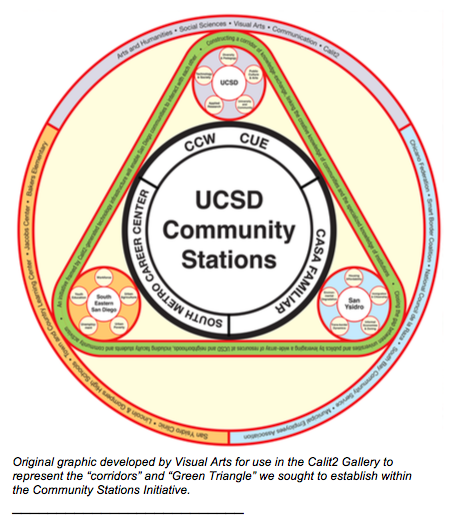
The Community Stations Initiative coalesced between 2010 and 2012. There were six major UCSD organizations involved: LCHC, the UCSD Departments of Communication, Engineering, and Visual Arts, the UCSD based portion of the California Institute for Telecommunications and Information Technology (Calit2), and UCSD Extension. Each organization played a different role, enabling the project to move beyond multiple conversations, across institutional/segmental lines, to concrete envisioning and implementation.
The objective of the project was to link UCSD with each of its community partners through a multimodal communication network that would enable community-community interactions at the same time that it enabled university-community interactions that focused on STEM education.
From the perspective of LCHC, this project permitted us to test out the process of setting up such a complexly mediated system, building upon our prior experiences working with community institutions and using what we now thought of as a “UC-Links Model.” We knew that if we had enough bandwidth and a compelling reason to interact, children in the two locations could, in fact, engage in quite complicated and interesting forms of STEM-related collaboration. The work described in earlier chapters had established such possibilities for a long time, but we had never tried to put three such systems into coordination, even with “the latest technology.”
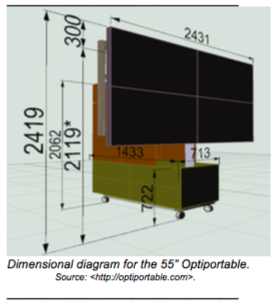
The newest technology in this case was called the OptiPortable. The OptiPortable derived its name from optical networking, its use of static IP addresses, and its portability. The system folded out from a 100-cubic foot wheeled container, and featured a high-resolution, 4-foot by 6-foot wall made of four large, LCD flat screens, built-in computers, and networking equipment, all of which were designed for the sharing of graphic information and two way communication.
Within the gallery and design lab at Calit2, we were shown the various potentials for sharing data (including high resolution pictures, videos, and other forms of digital representation) that the system could handle. We were encouraged, and the project was able to recruit some additional resources from several of its ensemble of partners to put together an actual plan for running UCSD courses. In the courses, undergraduate students from campus would take a class in which they spent a significant part of their time working side by side with youth from the Southeast San Diego Community, using the new technologies to coordinate activities on campus through the “knowledge corridors” provided by the OptiPortable technology.
That was the plan.

Various parts of that plan were carried out over the subsequent two years. First, a special event was held at Calit2, discussing the idea of the project to a mixed audience of academics and community members with an interest in the proposal. A gallery installation intended to demonstrate the viability of the project accompanied this event.
Later, that art installation, with its imagined activities, was used by Calit2 in its external evaluation as evidence of UCSD’s commitment to the university’s goal of serving a diverse population of students and their professed desire to be of assistance to their local, under-represented, communities.
Moving from imagination to action proved considerably more problematic. As described in papers by Harry Simón Salazar and David González-Hernández, who directed parts of the project and served as instructors for actual activities, a number of institutional failures threw up several barriers to impede the realization of the utopian goal to establish three way flows of information between the partners in the three geographical/institutional locales of the project.
During the first quarter, the focus of the community based course was led by the talented instructress Saura Naderi, who focused on robotics, a topic about which neither the UCSD undergrads nor the community youth had any special knowledge, but which both groups found interesting. To make robotics both fun and interesting, the class came up with the assignment of creating a mobile Santa’s Village out of cardboard, using programmed arduinos to decorate the model.
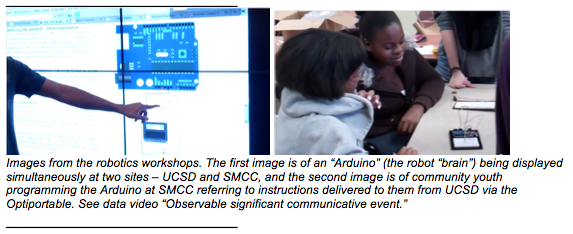
When Calit2 began the task of installing the devices in the designated locations, it was soon discovered that the demands of the equipment exceeded the capacity of their intended new homes, both in the community settings and at UCSD. The locales of each of the community sites struggled, but did not succeed, in providing their part of the infrastructure, and Calit2 tried to work around the problems, but the system never worked as planned. At UCSD, the equipment was moved into the nearest open space, which happened to be a sound deadened dark room, originally designed for entirely different purposes. We only had two-way, live video contact left at our disposal – a high resolution Skype.
The main robotics lesson, taught by Saura, was taught at the South Metro Career Center, while a mixed group of local youth and UCSD undergraduates gathered around two OptiPortable systems, over twenty miles away from each other, to collaborate at a distance on the construction of their robotic Santa’s Villages. Managing a long list of workarounds and compromises, the villages were built and functioned, if not elegantly. Most importantly, the activity was highly regarded by both the youth and the undergraduates, and there was no question that all concerned had learned a great deal. A part of the overall program could be made to work well under inauspicious circumstances.
For the second quarter, UCSD was unable to resolve problems of locating the OptiPortable systems, so a different institutional arrangement was worked out. The solution involved students from a local high school, Lincoln High, and UCSD students learning digital video production and collaborating to produce videos together about a topic of concern to the high school students. The UCSD students, almost all communication majors, were caste in the role of media savvy peers. The high school students were also considered the leaders within their high school, having primarily come from the “School of Social Justice.”
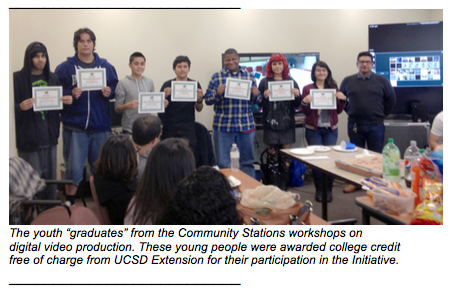
Again, this project produced results of precisely the sort that we had hoped for. Students from the University and local community sides of the joint activities learned a great deal about each other in the course of producing programs grounded on the social justice concerns of the youth. The collaboration to develop one such video became the focus of David González-Hernández’s dissertation, “Critical media participations: media literacy and youth-produced videos from Latina/o audiences in the U.S.-Mexico border.”
Despite their virtues, these attempts to coordinate all of the parts of the system in productive interaction failed to materialize. The ensemble of players was too distributed and too underfunded in too many of its parts to hold together. However, after a dormant period of about a year, the “Community Stations Initiative” re-emerged from the Cross-Border Community Station promoted by Teddy Cruz. Today it exists as a program housed within the UCSD Center on Global Justice.
Perhaps most substantially, the idea of a community station has been taken to a new level by a recent initiative of UCSD to create large, multimillion-dollar educational innovation hub in downtown San Diego.
The project we did with UCSD Extension:
Chapter Thirteen Compositors: Mike Cole, Harry Simón Salazar, Robert Lecusay, and Ivan Rosero.
Back to Chapter 12
Forward to Chapter 14
